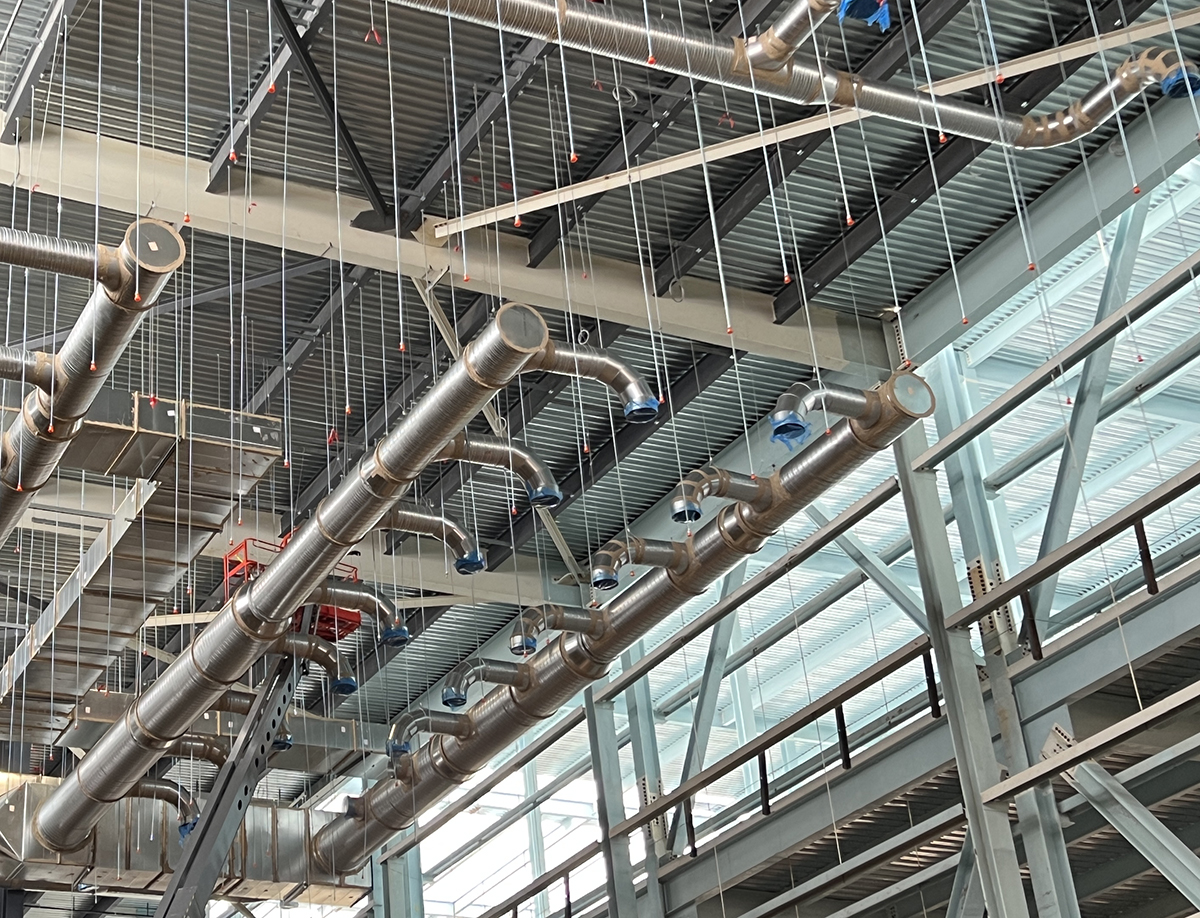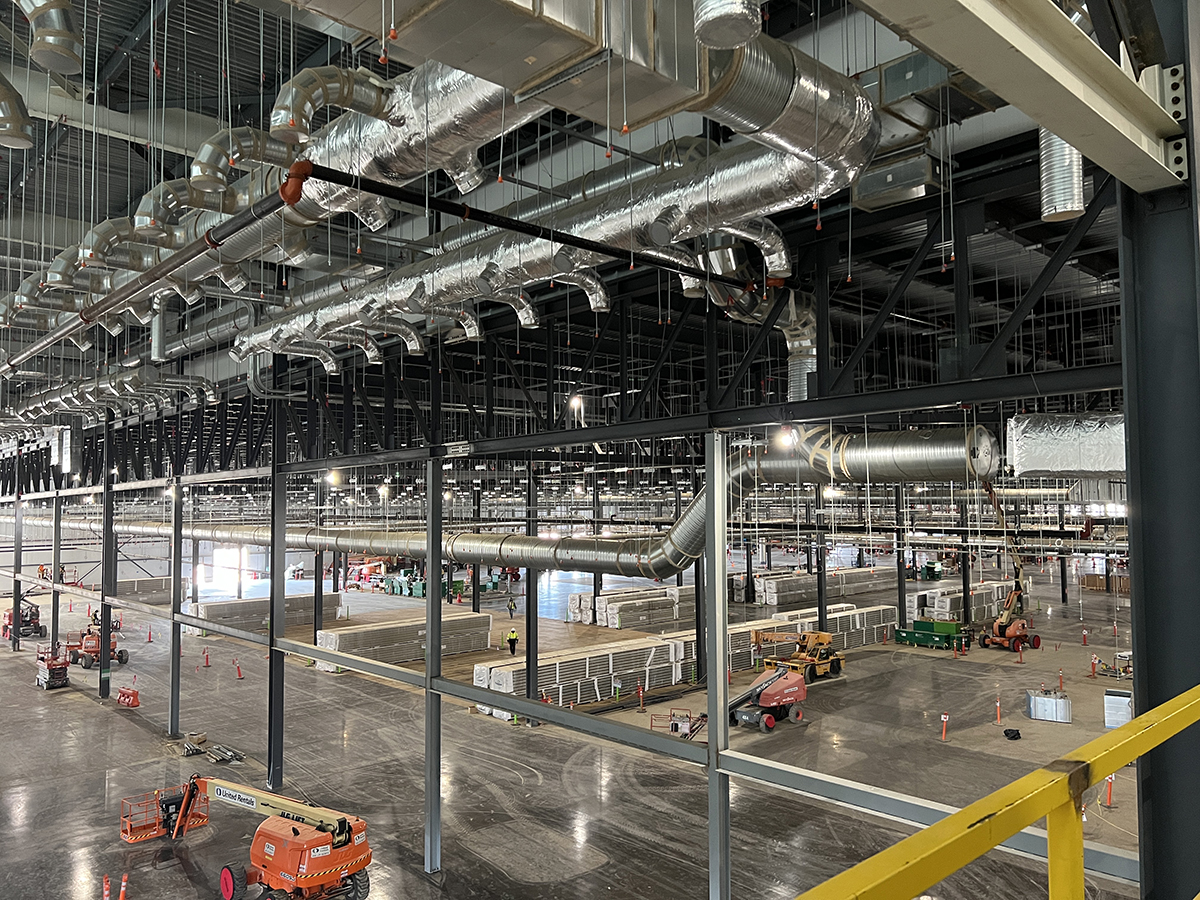Tackling One of the Largest Construction Projects in U.S. History
Pharmaceutical facility experience comes in handy during a job at an electrical vehicle battery manufacturing plant.
Poynter Sheet Metal of Greenwood, Indiana is part of one of the largest construction projects in United States history, which is transforming a small town. “It had a gas station and some people living in what they thought was a remote area,” says Joseph Lansdell, president of Poynter Sheet Metal in Greenwood, Indiana. “Now it's going to be an absolutely huge Electrical Vehicle battery manufacturing facility.” Each of the two main buildings will be about four and a half million square feet. “Overall, there are 13 outbuildings, which brings the facility to 10 million square feet.”
Matt Cramer, president of Dee Cramer, Inc. in Holly, Michigan learned about the massive project in late 2021 through his long-standing relationship with Barton Malow, a Michigan general contractor. Cramer asked Poynter to consider handling the project as a joint venture. After an interview process, Barton Malow’s client invited Poynter to join the team. Poynter has over twenty years of experience with automotive facilities, but their pharma resume was more important to this project. “We've done projects for Tesla down in Austin and worked with GM in Tennessee, but this is a battery producing factory,” Lansdell says. “A battery requires a super clean, super dry environment. It looks like a cleanroom we would do for a pharmaceutical facility.”
As they worked through the planning process, Cramer encouraged Poynter to take the lead. “I told him we will provide whatever pre-con and upfront support in design and estimating they need, so that's how we did it,” Cramer says. “Poynter’s doing an incredible job.”

On this project, Poynter used roughly 250 tradespeople onsite,
and the project will total several hundred thousand shop work
hours.
Poynter and Cramer worked with the owner and designers throughout 2022. “We put in several estimates to build the price and budget with the owner,” Lansdell says. “If you weren't in Michigan, you were in Zoom meetings that went four and five hours long. Probably the biggest input we had was in the schedule detail.” Poynter recommended changes in the way the job flows to match sequences. “We also went through estimates in front of the client’s people and an audit team. With that level of trust from the owner, we had to expose everything line by line to explain and support what we meant by our estimate.”
Poynter’s uses products like Autodesk’s Revit and CADmep to draw and plan the work. “CADmep is tied to our estimate, to our detailing, and to our productivity in the shop,” Lansdell says. “We use Bluebeam, we track 100% of our install using virtual tracking, and we have tablet technology in the field.”
Poynter mobilized to the site in the fourth quarter of 2022 and started installation that December. “In the field, we have a full office staff with their own comptroller, payroll clerks, accounts payable, accounts receivable, project managers, project engineers and safety staff,” Lansdell says. “We’ve treated it like its own company. We have college age students working in our project engineering and project management staff, and we took key people out of our office in Louisville, Kentucky.” Brian Neal, Poynter’s executive vice president, oversees the facility.
Each of the twin production plants is almost a mile long, so the sheer scale is the biggest challenge. “There’s over four million pounds of ductwork per building,” Lansdell says. “We are fabricating 100% of that in our 160,000 square foot shop.” The shop day shift has grown to 120 people with a smaller night shift of 30-40 people. “We have three lasers dedicated just to ventilation cutting.” They are purchasing some items, like 16,000 round elbows.
Poynter is responsible to set all air handling equipment, a huge commitment with 32 coater oven air handling units, 128 building air handling units, 90 direct heating units, and 384 fans. The project will bring Poynter several hundred thousand shop workhours, several hundred thousand field workhours, and 50 to 60,000 hours of detailing time.
Poynter has about 250 tradespeople on site. “We've had good success recruiting as far as 75 miles away,” Lansdell says. “Because we've onboarded new workers, we set up classes on site to teach simple skills like how to seal the network properly. It's really helped our quality.”
Attendance has been a surprise challenge. “We are working six days a week and ten hours a day on this project, and we have other jobs going at the same time,” Lansdell says. “We have several workers who travel 50 miles to work each day, then go home. Working 6/10s for an extended period really wears on people, so that's been a nuance we didn’t think about when we started. We’ve had to plan for a certain level of absenteeism, especially for the workers who are traveling.”
Published: October 30, 2023
IN THIS ISSUE
5 Reasons Why Belonging Matters
BE4ALL (Belonging and Excellence for All) lauched in December 2021. The initiative envisions a diverse, inclusive and unionized sheet metal industry that is welcoming and fosters belonging for all.
A Milestone Coup for Contractors
The Davis-Bacon Act final rule is a win for SMACNA members and quality-driven contractors bidding on federal and public works projects.
Budget & Forecast Your Way to a Profitable 2024
Because private companies don’t face the same scrutiny and reporting requirements as their public counterparts, the budgeting and forecasting process is often overlooked or underutilized by many construction companies.
Choose Your Social Media Platforms Wisely
Ready to add social media to your marketing strategy? Target the platforms that fit your business needs for best results
Duct & Cover
Hohler’s Furnace and Sheet Metal tackles the HVAC for a shooting range.
Everyone Is Invited — BE4ALL
Forget the quotas. No more arbitrary demands. The purpose of Belonging and Excellence for All (BE4ALL) is to meet real-world demands for the best, most qualified workforce available for the industry.
Fall Brings Positive Energy & Continued Focus
SMACNA's CEO talks about the need for SMACNA contractors to become as involved as possible in the political process and outlines some of the tools that have been provided by SMACNA's Government Affairs team.
Installing Sculpted Sheet Metal
Indianapolis-based Gainbridge Fieldhouse entrusts the installation of two new sculptures to SMACNA member.
Labor Board Issues Several Significant Decisions
Over the past month, the National Labor Relations Board (NLRB or Board) has issued several significant decisions, including expanded scrutiny of employer policies and handbooks, an expansion of what constitutes “protected concerted activity” and two
Lisa Davis: A Trailblazer & Teacher
Lisa Davis is the first woman administrator of the National Energy Management Institute and a voice for mentorship, opportunity and inclusion.
Look at the Entire HVAC System to Maximize IAQ & Gain a Competitive Advantage
SMACNA's President outlines the need for contractors to understand how to leverage their skills and resources to deliver maximum value to their clients while also meeting their operational needs in this ever changing environment.
SMACNA Endorses the IRS Tax Credit Direct Pay Rules & a SMACNA Issue Scorecard
The Inflation Reduction Act of 2022 (IRA), Public Law 117-169, not only introduced a range of new and enhanced clean energy-related tax credits, but also created two new ways for taxpayers and tax-exempt entities to monetize these credits.
Tackling One of the Largest Construction Projects in U.S. History
Pharmaceutical facility experience comes in handy during a job at an electrical vehicle battery manufacturing plant.
Welcome New SMACNA Members



